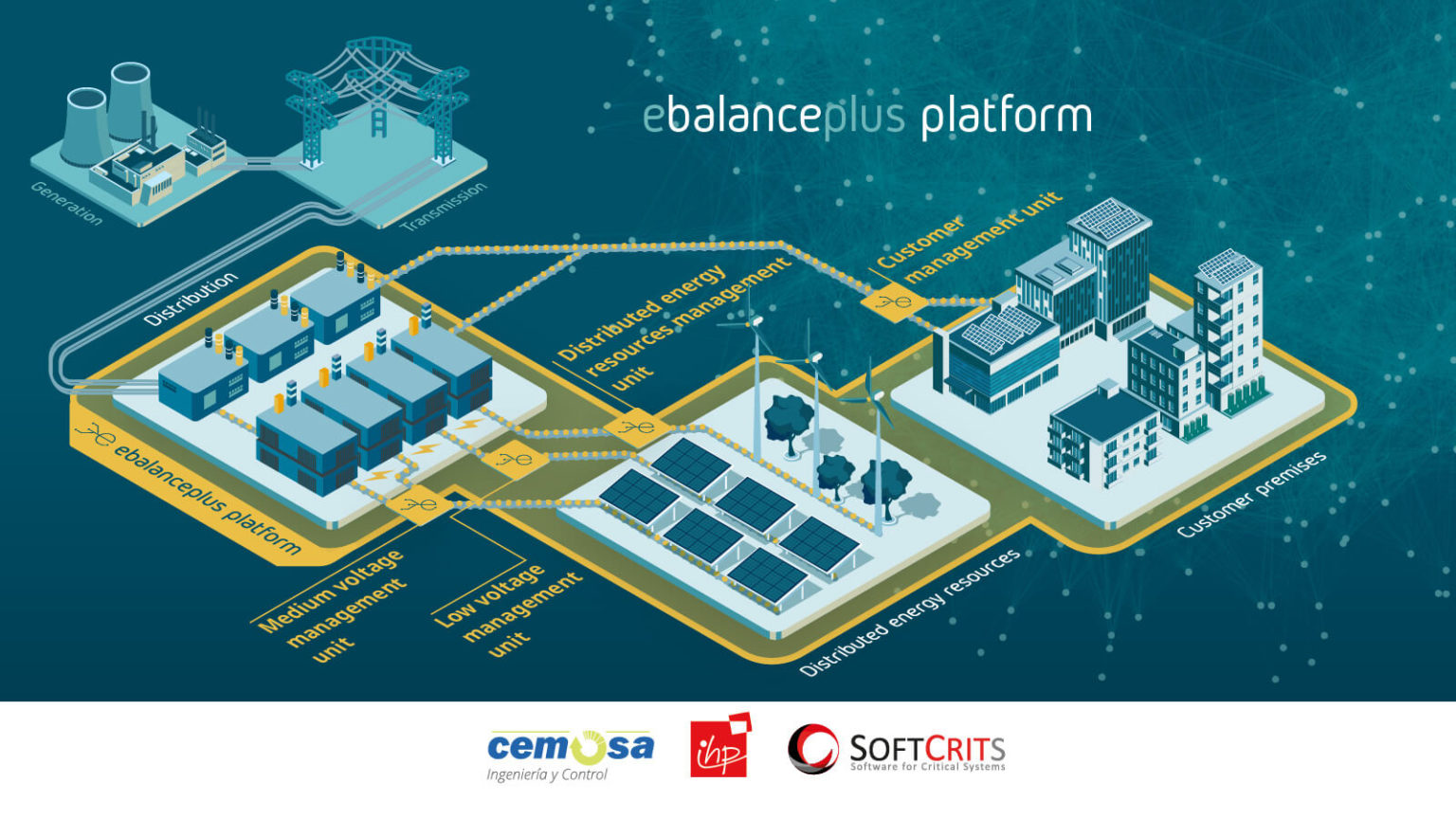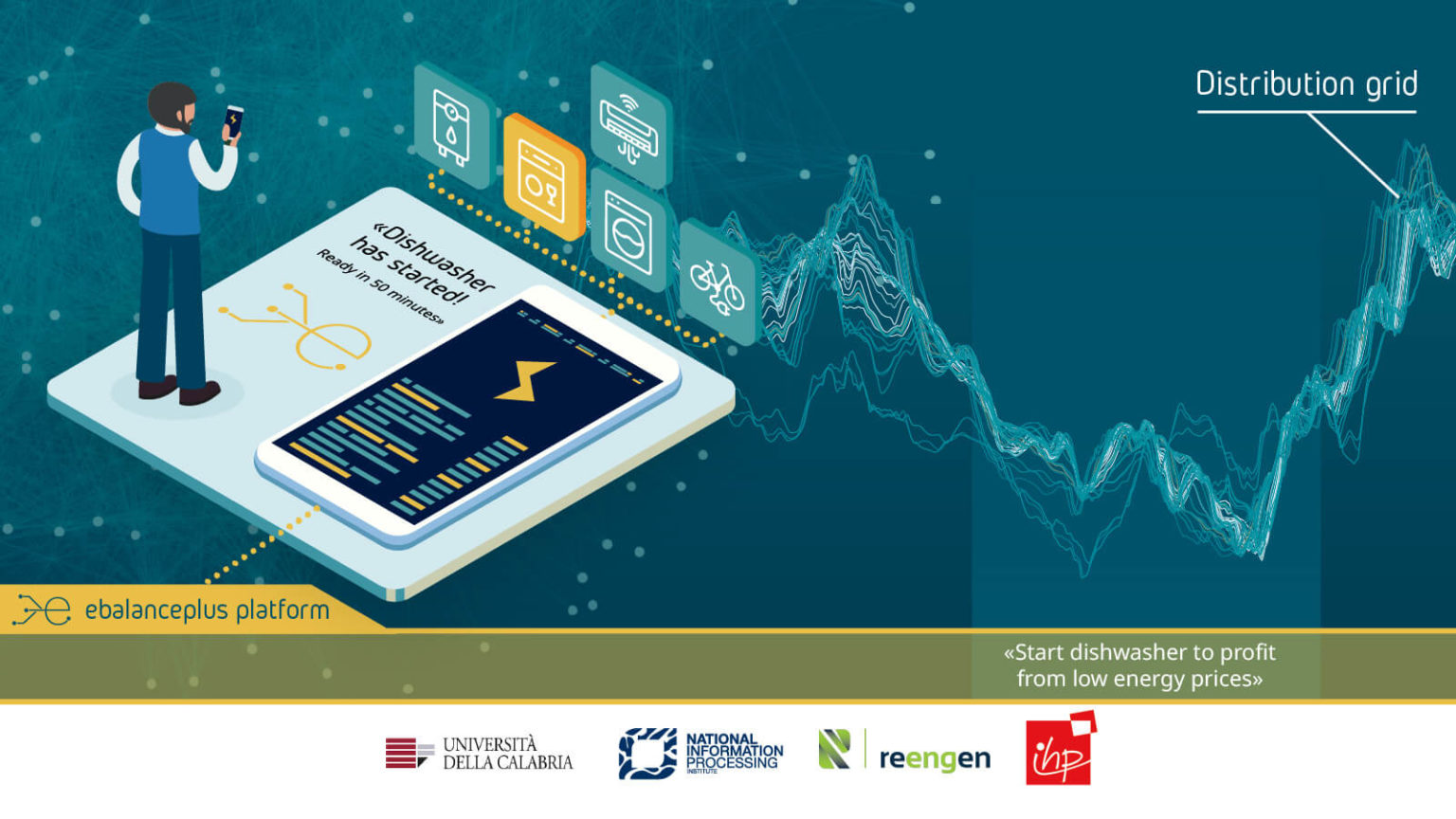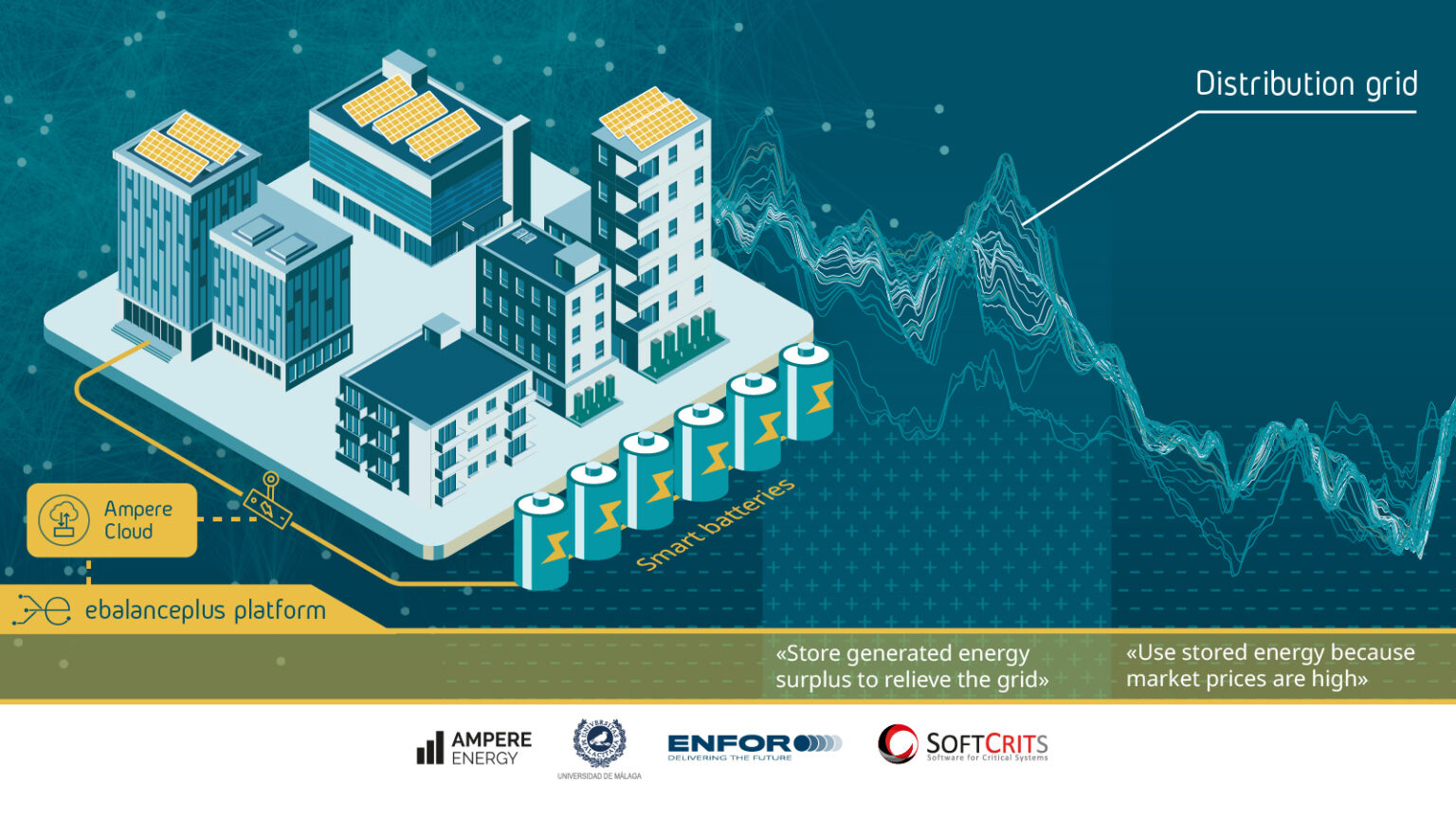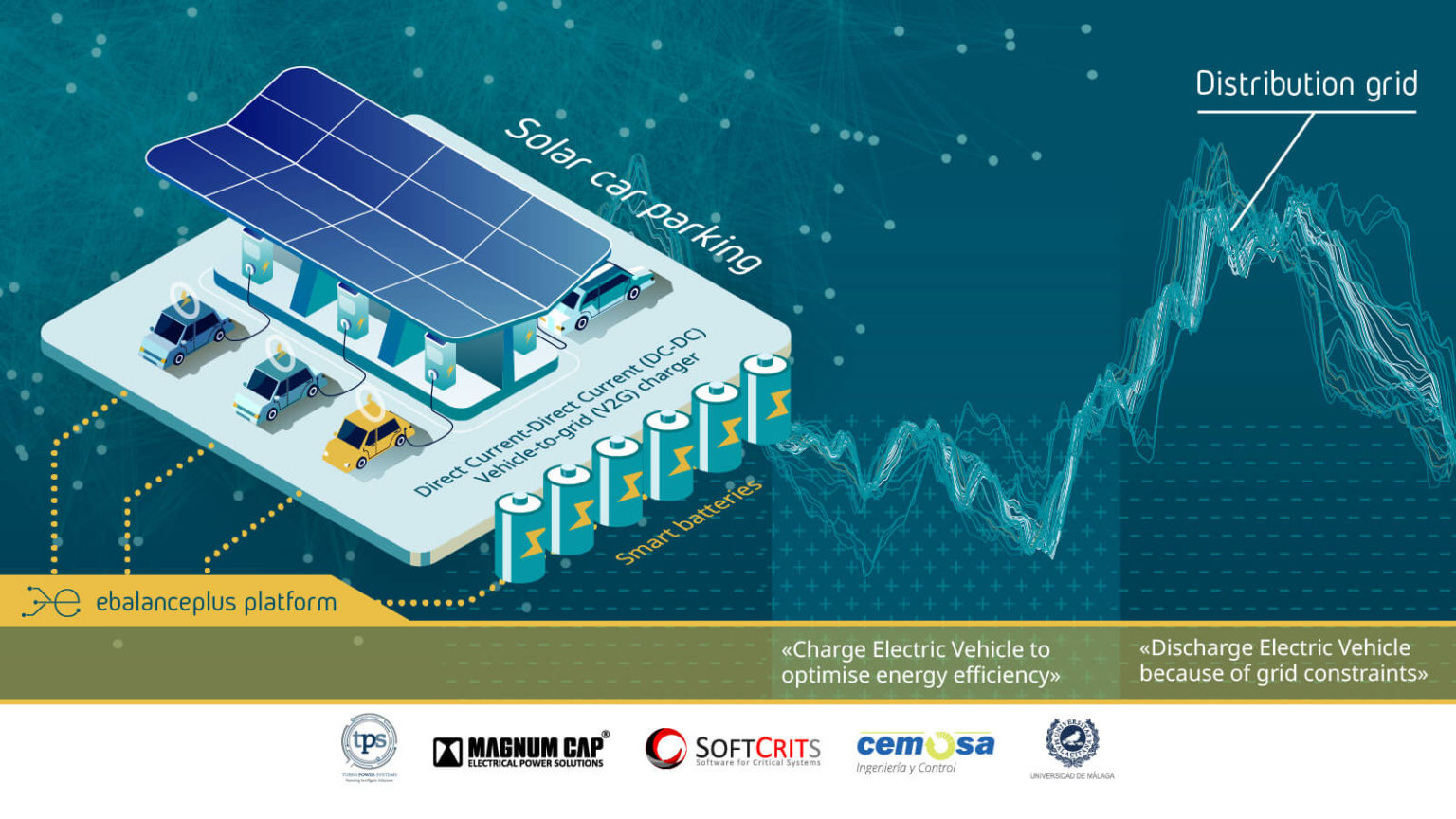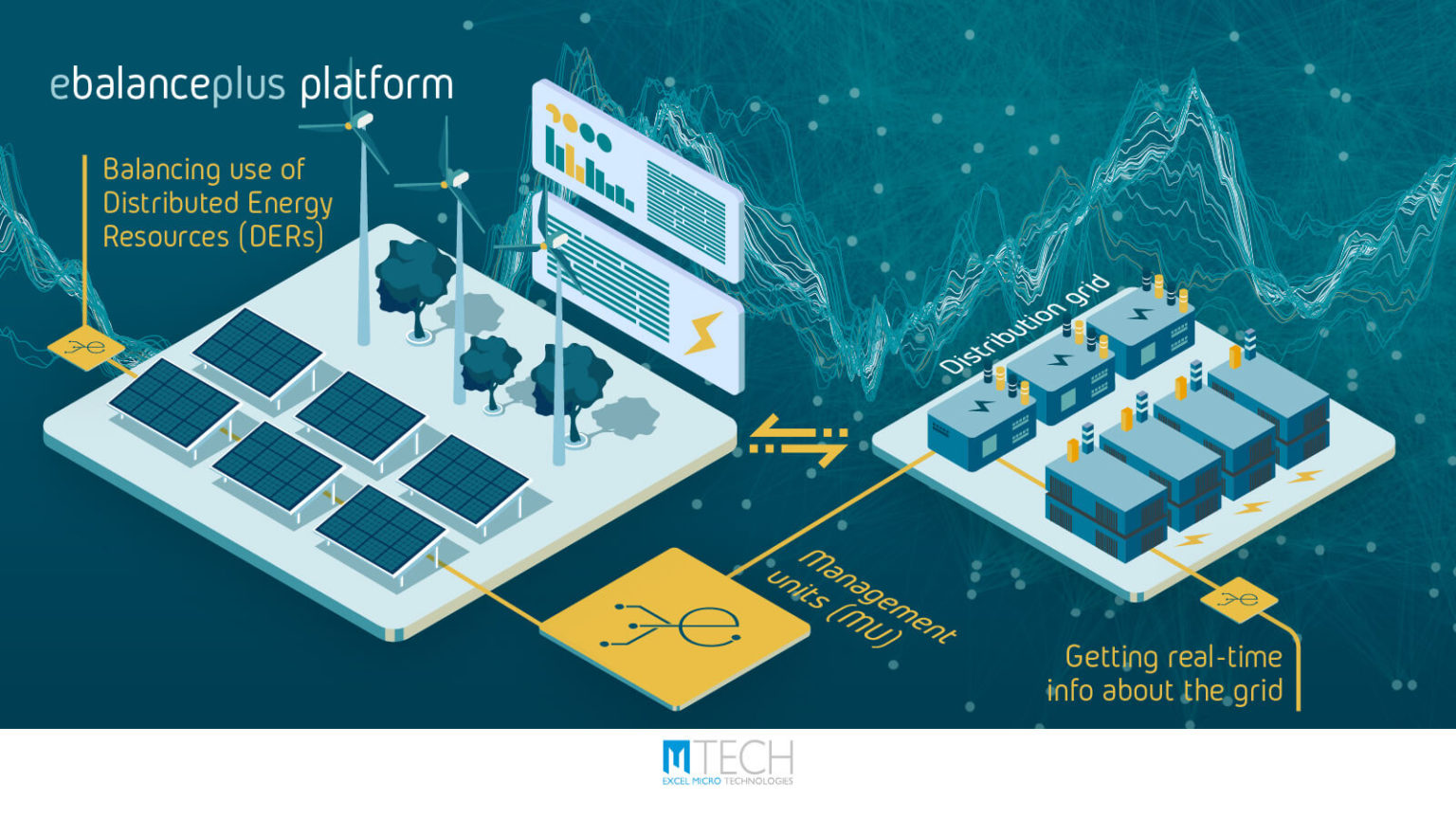The project
The context
Smart electricity grids play a crucial role in the current energy transition, enabling better integration of the renewable sources of energy into the grid and a more efficient use of energy altogether.
The EU-funded project ebalance-plus will develop smart-grid solutions to increase the energy flexibility and the electric grid observability, providing new services for distribution grid operators, transmission system operators, aggregators, energy retailers, DER managers, building facility managers, prosumers, and consumers, empowering them with more functionalities to interact with the grid and manage the energy flows.
Our approach
The aim of the project is to increase the use of flexibility and resilience of energy networks, by means of an energy balancing platform, which will integrate smart production, storage and consumption technologies.
This energy balancing platform is based on a fractal-like hierarchical architecture that replicates the existing grid topology with a bidirectional communication framework, assuring the scalability of the solutions.
Our approach is to unlock and increase the energy flexibility from buildings and districts and make it available for DSO management.
The project will test a variety of solutions at four real demonstration sites located in Spain, Italy, France and Denmark. Additional laboratory testing in Germany will address safety issues.
Another important aspect of the project is its social and market orientation. From the outset, the project takes into account users’ needs and concerns in terms of energy usage and innovation. This increases the chances of the market adopting the technology.
The project work plan covers a 4-year period and involves 15 partners from 10 countries who perform research, analysis, evaluation and exploitation to achieve future replicability.
Key results
1- Ebalance-plus modular and scalable energy-management platform
The ebalance-plus comprehensive energy balancing platform enables different electric grid players and operators (prosumers, DER exploitation manager, energy aggregator and DSOs) can deal with the available flexibility to increase the grid stability and security.
It is based on bi-directional communication between units, and a hierarchical and fractal-like architecture. The platform delivers flexibility mechanisms & energy efficiency services. It provides a data-centric programming abstraction which allows all devices in the smart grid to exchange data in a seamless manner and will provide interoperability with external systems.
The platform:
- enables reliable communications to exploit energy flexibility as a commodity.
- improves management of hidden flexibility of buildings and distribution grids.
- is based on bi-directional communication between units, and a hierarchical and fractal-like architecture.
- delivers flexibility mechanisms & energy efficiency services.
- Target users: Energy retailers, DER exploitation managers, energy aggregators, DSOs, energy consumers/prosumers (industry, tertiary, households)
- Technological Readiness Level (TRL): 7
2- Home energy management mobile app
Our home energy management mobile app engages users with its customised interfaces for stakeholders such as building users, electrical vehicle (EV) users, facility managers, and system operators. The design of the app includes the integration of various data streams and integration with a diverse set of algorithms. The app is compatible with market standards and other global market solutions. Its users can optimize their energy effciency reduce energy bills and COs emissions.
The app:
- simplifies the (interaction with) complex energy (flexibility) services from building and smart grid management platforms for users.
- provides, among other things, price based notification, abnormal consumption alarms, and load shifting recommendations.
- Target users: Energy consumers/prosumers, building facility managers, campusses
- Technological Readiness Level (TRL): 8
3- Smart storage solutions to unlock and manage building flexibility
Our smart storage solution unlocks and manages building’s energy consumption flexibility, either locally or by receiving flexibility requests from an external management system or platform like ebalance-plus. Locally, thanks to its own Energy Management System, it learns and estimates the consumption and generation patterns of the building, optimizing the charge and discharge profiles through the day, to get the most economic savings and self-consumption to the prosumer. In communication with the ebalance plus platform, it will be able to receive either price signals and flexibility requests, for either indirect or direct demand side management or flexibility services schemes.
This smart storage solutioin supports a great variety of use cases. Thanks to its state-of-the-art Energy Management System, it learns and estimates the consumption and generation patterns and uses these estimations to optimally plan charge and discharge through the day in order to get the most economic savings and self-consumption to the prosumer. It can also peak-shave, act as a reliable back-up or even follow commands sent to it by authorised parties. This last functionality renders the device easy to integrate into any third-party software, as being demonstrated in the ebalance-plus project.
- Target users: Aggregators, DSOs, Building facility managers
- Technological Readiness Level (TRL): 7
4- Prediction models for energy flexibility forecasting
Due to the increase of renewable energy sources and its participation in the ancillary services market, it is necessary to have a better cooperation between DSOs and TSOs.
Our forecasting services will help to reach this goal by providing high quality data at market level, and also by introducing forecasts for new technologies such as the batteries which will help to the grid stability.
The ebalance-plus forecasting services deliver high quality forecast data on a very fine-granular level, and thereby enable new possibilities for the electric market.
Three new products have been developed in the project:
- forecasting of solar PV installation
- forecasting of energy consumption
- forecasting and scheduling of EV charging
- Target users: TSOs, DSOs, prosumers (e.g. solar parks)
- Technological Readiness Level (TRL): 5
5- Cloud based grid optimization platform
This cloud based gird optimization platform targets isolated grids and aims to achieve energy management & balancing with maximum use of Distributed Energy Resources. This solution enhances the company’s software in this direction by providing robust technical solutions for supply-demand balancing of smart grids. The cloud based grid optimization platform using advanced energy optimization algorithms based on AI.
A set of functionalities for DSOs is provided by this solution:
- ΙΕΝ 50160 for Voltage Quality
- Fault Detection, Isolation and Restoration (FDIR)
- Volt/Var Optimization
- Intentional Islanding after cascading failures
- LV transformer status monitoring with PMUs and Sensors
- Target users: DSOs
- Technological Readiness Level (TRL): 5
6- Integrated Smart Hub - Solar carparking with battery energy storage and V2G electric vehicle charge management
Our smart hub is an integrated solar carpark with battery energy storage and V2G electric vehicle charge management, delivering flexibility services. The solution uses DC-DC V2G chargers supported by silicon carbide-based power inverters at district level, reaching the highest state-of-the-art performance. This approach reduces AC/DC conversion losses, the size and cost of components and facilitates the integration and reliability.
Benefits/Services achieved by the smar thub are:
- flexibility service for the distribution grid using EVs: overcoming grid constraints;
- enabling energy usage and supply flexibility to optimise energy costs in an environmentally friendly manner (optimise energy efficiency);
- avoiding conversion losses by improving power conversion efficiency;
- reducing grid connection costs;
- better energy management leading to benefits for both EV owners and parking lot owners.
- Target users: EV fleet owners, car park owners, aggregators, charge point operators, tertiary sector (e.g. hotels, universities, airports, etc.)
- Technological Readiness Level (TRL): 6
7- Grid control and automation units
Our grid control and automation units for medium (MV), low (LV) voltage grids, and distributed energy resources (DER), offer the Transmission System Operators (TSOs), Distribution System Operators (DSOs) and integrators an advantageous solution to support the increase of renewable energy sources (RES) penetration, seamless integration of field devices, backend applications, and end-users.
The control and automation units for MV & LV grids are based on a modular architecture and host enough processing power for edge intelligence with the goals to:
- increase the electric grid observability,
- increase the system’s reliability and security and
- exploit the available flexibility for the benefit of its users.
- Target users: DSOs, DER owners
- Technological Readiness Level (TRL): 7
8- Control and optimization models for energy management systems
Designed/refined/improved control and optimisation models for energy management systems. These models are capable to describe the actual behaviour of the technology/energy system to be controlled, and be easily scalable and interoperable. The following models have been developed:
- Electric boiler optimisaiton baed on market signals (for CO2/energy cost building optimisation) by DTU
- DER optimisation (optimisation of DC networks) by UNC & UMA
- PV forecasting & building demand forecasting (next 24 hours with 15 min granularity) by JUN, UNC, UMA
- V2G forecating by UMA
- Energy demand forecasting based on agent models by UMA
- Target users: Researchers, energy managemenet system developers
- Technological Readiness Level (TRL): 7
Partners
Discover our partners
